How Much Does It Cost to Install a Backsplash?
The backsplash is the most decorative part of a new kitchen design. Backsplashes were used as a practical way to protect the wall behind a cooktop from splatter. With new cleaning implements and tougher paint, the backsplash has evolved into an optional kitchen feature to show style or personal taste. Backsplash installation remains very popular for homeowners across the country. However, increasing costs for raw materials and continued labor shortages will likely cause price increases through 2023 and beyond. Expect the cost of backsplash installation to increase from 3% to 10%, depending on where you live and the availability of materials and labor in your area.
The average backsplash is roughly 30 square feet and can be made of nearly any material. With varying material costs, this can lead to large price ranges for the project. The national average cost for a new backsplash is $900 to $2,100. Most people spend around $1,500 for a 30 sq.ft. white marble subway tile backsplash installed in a running bond pattern along the counters and a herringbone pattern behind the cooktop. This project’s low cost is $200 for installing 10 sq.ft. of backsplash with a single row of straight set 4” ceramic tiles along the countertops only. The high cost is $7,500 for an installed 30 sq.ft. granite slab backsplash and an exotic stone behind the cooktop.
Backsplash Cost
| Backsplash Installation Cost | |
|---|---|
| National average cost | $1,500 |
| Average range | $900-$2,100 |
| Low-end | $200 |
| High-end | $7,500 |
In this guide
Backsplash Cost by Material
Slab Backsplash vs Tile Cost
Cost of Tile Backsplash by Tile Size
Backsplash Installation Patterns
Backsplash Labor Cost per Square Foot
Backsplash Replacement Cost
Backplash Installation Shapes
Pros and Cons
Backsplash Material Comparison
Bathroom vs Kitchen Backsplash
Enhancement and Improvement Costs
Additional Considerations
FAQs
Backsplash Installation Cost by Project Range
Backsplash Cost per Square Foot
The cost to install a backsplash 1 per square foot ranges from $20 to $70, depending on the material and complexity of the kitchen design. Material costs average between $1 and $50 per sq.ft. To help estimate costs, keep in mind that the most common backsplash height is 18 inches from the top of the countertop to the bottom of the cabinet’s underside. This amount of space holds 6 rows of 3x6 tiles, 4 full rows plus a 2-inch border of 4-inch tiles, 1 row of 18-inch tiles, 1½ rows of 12x12, or 12x24-inch tiles, or 6 rows of 3-inch tiles. It is very common to mix tile sizes to fill the space, creating a unique pattern. Older kitchens with shorter upper cabinets as well as countertops with an integral backsplash usually have a backsplash area of 14 to 15 inches. The table below shows the most common backsplash sizes and their respective costs based on average materials.

| Size | Cost (Materials Only) | Cost (Installed) |
|---|---|---|
| 10 sq.ft. | $100 - $500 | $200 - $700 |
| 15 sq.ft | $150 - $750 | $300 - $1,050 |
| 20 sq.ft. | $200 - $1,000 | $400 - $1,400 |
| 25 sq.ft. | $300 - $1,250 | $500 - $1,750 |
| 30 sq.ft. | $400 - $1,500 | $600 - $2,100 |
| 35 sq.ft. | 500 - $1,750 | $700 - $2,450 |
Backsplash Cost by Material
Backsplashes are a unique area in the home. They have no foot traffic or exposure to moisture. They occasionally see splatters from grease and food substances. You can install nearly any material in the backsplas area, but some materials require stain protection. The amount of cooking you do and the types of foods you cook impact how easy the material is to maintain. With a range of backsplash materials available, there are both budget-friendly options for small kitchen upgrades and more luxurious backsplash slabs to elevate your kitchen design and style. Below are the average costs for the material and installation for an average 30 sq.ft. backsplash.

| Type of Material | Cost per 30 Sq.Ft. (Materials Only) | Cost per 30 Sq.Ft. (Installed) |
|---|---|---|
| Chalkboard Paint | $20 - $25 | $170 - $325 |
| Wallpaper | $30 - $50 | $110 - $250 |
| Stone | $38 - $6,000 | $188 - $7,500 |
| Beadboard Panels | $90 - $840 | $270 - $1,290 |
| Mirrors | $240 - $450 | $480 - $780 |
| Brick | $300 - $400 | $500 - $700 |
| Glass | $600 - $900 | $900 - $1,500 |
| Metal | $600 - $1,500 | $900 - $3,000 |
| Ceiling Tiles | $900 - $1,500 | $1,200 - $3,000 |
Chalkboard Backsplash Cost
The cost of the paint is $20 to $25 for a gallon to cover a 30 sq.ft. backsplash. The cost of having a chalkboard backsplash professionally painted is $170 to $325. If you like constantly decorating and drawing on your backsplash, create a chalkboard wall. Chalkboard backsplashes are made by applying chalkboard paint to the wall. This dark paint is easy to clean and allows you to write on your walls. However, painting your entire backsplash black like this can make your kitchen appear dark.
Kitchen Backsplash Wallpaper Price
The wallpaper costs range from $30 to $50 for a 30 sq.ft. backsplash. Professionally wallpapering your backsplash averages $110 to $250. If you like the idea of having color, pattern, and texture on your backsplash, but do not want tile, wallpaper makes an excellent choice. Wallpaper for use on a backsplash is often made of thicker material that can be wiped down. This makes it easier to clean and care for and gives you the many patterns of wallpaper. Do not use wallpaper meant for other parts of the home because it could be damaged.
Stone Backsplash Cost
A stone backsplash offers luxurious style that makes it a worthwhile investment for many homeowners. Prices range from $38 to $6,000 for 30 sq.ft. of materials and $188 to $7,500, including installation. If you have stone countertops, you can select a stone backsplash to match for a cohesive, contemporary design. The marble and quartz backsplash costs are higher to reflect the premium quality and durability of these materials. Marble is one of the top picks for a stone backsplash because this compressed limestone is harder and more durable than many other materials. Quartz is a man-made material composed of roughly 90% natural quartz rock and 10% pigments and resins. It is stain-resistant and much easier to match and care for than natural stone. Engineered stone is a mixture of pigments, resins, and quartz, making it one of the hardest and most durable materials used in home surfaces. Granite tiles are less common, although granite slabs are an elegant yet expensive choice. The below table shows the costs for materials only and installing an average 30 sq.ft. backsplash.

| Type of Stone | Cost per 30 Sq.Ft. (Materials Only) | Cost per 30 Sq.Ft. (Installed) |
|---|---|---|
| Ceramic | $38 - $3,000 | $188 - $3,300 |
| Porcelain | $90 - $900 | $300 - $1,200 |
| Travertine | $150 - $900 | $390 - $1,200 |
| Marble | $150 - $4,000 | $390 - $6,000 |
| Quartz | $300 - $3,000 | $600 - $4,500 |
| Engineer Stone | $300 - $3,000 | $600 - $4,500 |
| Granite | $300 - $6,000 | $600 - $7,500 |
Beadboard Backsplash Cost
On average, materials for a beadboard backsplash cost between $90 to $840. Installed, the cost of a beadboard backsplash averages $270 to $1,290. While beadboard is most commonly used in bathrooms, mudrooms, and ceilings, it gets some use on backsplashes. Beadboard is made up of thin strips of wood or beads placed over the edges of wider boards. It can be found in many types of wood and even some plastics and vinyls today, making them easier to clean. Beadboard can be wood-toned but is usually painted white.
Mirror Backsplash Cost
The materials for a mirror backsplash average from $240 to $450. The cost of a mirror backsplash is $480 to $780 installed. If you have a small or dark kitchen, use a mirror backsplash to look bigger and brighter. Mirrored backsplashes can be made of one large mirror or many mirrored tiles. Mirrors reflect light and their surroundings, making the kitchen seem larger. They are hard to keep clean in this area and require frequent cleaning.
Brick Veneer Kitchen Backsplash
Brick veneer backsplash material costs $300 to $400 for the materials and $500 to $700, including installation. Brick adds a solid, classic touch to your kitchen while protecting the wall against damage. Red, gray, and multi-colored bricks are most popular for backsplashes. You can choose from smooth and weathered finishes as well as masonry brick and faux brick veneer panels. Brick veneer is fireproof, making it suitable for use behind cooktops. It can be cleaned with soap and water. While this hard backsplash is impact resistant, it does need to be sealed, so it lasts for a long time.
Glass Backsplash Cost
The cost of the glass tile alone ranges from $600 to $900, while the cost to install glass tile backsplash ranges from $900 to $1,500. Glass backsplashes are another solution for dark or small kitchens. Like mirrors, glass tiles reflect a lot of light, helping dark and small kitchens seem bigger and brighter. Glass tiles come in multiple colors, styles, and sizes. You can opt for handmade glass for a traditional look or sleek, color-backed glass for a contemporary appearance. Glass tile is easy to clean, but it is difficult and expensive to install.
Metal Backsplash Cost
A metal backsplash is a popular option if you have a modern or contemporary kitchen and want to make a great style statement that stands out from the countertops. Materials for these backsplashes average from $600 to $1,500. With installation, they range from $900 to $3,000. Stainless steel backsplashes are easy to clean and care for and have a dramatic appearance. They can be made of solid sheets of steel or tiles in several shapes, sizes, and patterns. Aluminum is another choice that makes an interesting and contemporary backsplash. Many aluminum tiles, including unique mosaics, come in different shapes and sizes, although this material can melt easily and should be used away from the cooktop. The table below outlines the cost per 30 sq.ft. for materials only and installation with different metal backsplash materials.

| Metal | Cost per 30 Sq.Ft. (Materials Only) | Cost per 30 Sq.Ft. (Installed) |
|---|---|---|
| Stainless Steel | $600 - $1,500 | $900 - $2,250 |
| Aluminum | $600 - $1,500 | $900 - $2,250 |
Ceiling Tile Backsplash Price
Creating an installed backsplash using ceiling tiles costs $1,200 to $3,000. The cost of the ceiling tiles averages $900 to $1,500. If you are a fan of repeating embossed patterns, ceiling tiles can make very interesting backsplashes. Ceiling tiles come in many sizes, materials, and colors, including some you can paint. Ceramic, glass, granite, and tin ceiling tiles are a few materials that can be used. They create intricate and repeating patterns on backsplashes that are very dramatic, but they are hard to keep clean.
Slab Backsplash vs Tile Cost
When installing a backsplash, you can choose a slab or tiles. A slab is one solid piece of natural or engineered stone installed on the wall, while tiles are much smaller pieces used to create a pattern. The visual effect differs between the two. A slab backsplash in marble, quartz, or granite provides a smooth, uninterrupted design for a super clean look. However, traditional ceramic, glass, travertine, or porcelain tiles still remain popular in modern home design thanks to their distinctive aesthetic appeal. While a slab backsplash saves labor time because it does not require grout for individual tiles, it does need to be measured and cut precisely to ensure the proper fit. Overall, a solid slab backsplash installation costs around $50 to $90 per sq.ft., compared to $20 to $70 for a tile backsplash.

| Type | Cost per Sq.Ft. (Installed) |
|---|---|
| Tile | $20 - $70 |
| Slab | $50 - $90 |
Cost of Tile Backsplash by Tile Size
Backsplash tiles are available in many sizes, shapes, and patterns, influencing the overall design and project costs. The size is especially important when determining the cost of backsplash installation. Tile heights typically range from 1 to 4 inches, although taller tiles are available in certain styles. Professional backsplash installers can also blend different tile sizes to make a unique design that enhances the look and feel of your kitchen. The table below outlines the average cost of tile backsplash installation by popular tile sizes.

| Tile Size | Cost per Sq.Ft. (Materials Only) | Cost per Sq.Ft. (Installed) |
|---|---|---|
| 1’ x 1’ | $20 - $75 | $40 - $150 |
| 2’ x 2’ | $5 - $50 | $10 - $100 |
| 2’ x 4’ | $5 - $50 | $10 - $100 |
| 3’ x 6’ | $1.25 - $30 | $2.50 - $50 |
| 4’ x 4’ | $1.25 - $30 | $2.50 - $50 |
Backsplash Installation Patterns
It is common to install tile or other materials on your backsplash in a pattern. Any pattern other than a straight-set tile increases the project’s costs by between 10 and 20%, due to the extra material needed and the time to cut and lay. Common tile patterns include straight and off-set tiles. These are the most common and easiest to install. You can off-set tiles of any shape. While the rectangular off-set tile is the most common, you can also off-set square tiles. You can also stack rectangular tiles both horizontally and vertically, rather than off-setting them to change the look.
For more decorative backsplashes, both diagonal and herringbone patterns are common. These both involve taking the tile and rotating it at an angle - so these patterns tend to be more costly than straight due to the number of cuts necessary. If you want to use two different tiles, you can mix them in the same shape and size within one pattern or choose a pattern that combines two different sizes, such as a step or cut-corner pattern. Both of these can mix materials and colors as well as sizes to give you a more in-depth appearance to your installation.

Backsplash Labor Cost per Square Foot
A tile installer or kitchen remodel contractor can install your kitchen backsplash safely and efficiently. The labor cost of installing a backsplash varies depending on the material, shape, size, and the backsplash area’s condition. Installation costs start at around $5 a sq.ft. for simple materials like ceramic tile and can approach $30 a sq.ft. for more intensive work, such as installing a slab backsplash. Most people find that they pay close to $10 a sq.ft. in labor for most installations, but this varies depending on the material, thickness, and pattern. While square foot is the normal way of charging, some installers will charge $40 to $60 per hour instead.
Your backsplash installation will vary depending on whether you use tiles or solid materials like slabs or steel. Tile is the least expensive to install, but it takes the most time for the installation. The space is measured before installation, and a dry layout is done nearby. The tiles are placed in an area of the same shape and size to determine the proper layout and make cuts to fit the tiles or other material to the backsplash and any outlets.
For installation, the most common method of completing the space is to spread a small amount of mortar 2 on the wall. Then, the tiles are set in a predetermined pattern. After tiling, the mortar cures for 24 hours, and the backsplash is grouted 3 and requires another 24 hours to cure. If the material is crackled ceramic or natural stone, it must be sealed before grouting. For a 30-square-foot backsplash, the entire process takes just a few hours for installation and another one to two hours the next day for grouting.
For slab installations, this is done at the same time as your countertop. The slab is fabricated to fit, complete with cutouts for electrical outlets. Outlet extenders are placed in the walls, and adhesive is applied to the installation area. The slabs are fitted into place, and epoxy 4 is used in any seams 5 to seal them. The fabrication process can take 2 to 3 weeks, but the actual install can often be done in under an hour.

Backsplash Replacement Cost
A kitchen backsplash is easy to replace on its own or during a larger kitchen renovation. Even though backsplash tiles are designed to last a long time, sometimes tiles can be damaged in accidents. If you cannot find enough of the same tile to make repairs, replacing the backsplash with a new design may be a good idea. If the original tile was installed correctly, it can be gently pried off the wall with little to no damage. Removing backsplash adds roughly $1 to $3 per sq.ft. to your total backsplash replacement costs. If care was not taken when removing the old tile, you may need new drywall 6 before the new tile can be put up. In this case, expect an additional $3 a sq.ft. to install new drywall. This is not common because even minor damage can generally be covered by the new backsplash material without issue. The average cost of replacing a 30 sq.ft. kitchen backsplash is $930 to $2,590, depending on the material and design.
Cost to Replace Kitchen Countertops and Backsplash
It is common to switch out your backsplash when you replace your countertops. If you want to take care of both projects at the same time, it may be slightly less expensive than if you replaced them separately. This is because the old backsplash may be damaged when the countertop is removed, and the backsplash needs to be mounted 7 on top of the counters. Expect to pay $1,500 to $4,500 for a new countertop, in addition to your new backsplash costs of $900 to $2,500. This makes for a total of $2,400 to $7,000 to replace kitchen countertops and backsplash at the same time, with prices depending on the materials you choose. Removing an old backsplash to install a new one is a simple job that costs around $1 to $3 per square foot.
Backplash Installation Shapes
While you can use nearly any material, most materials are sold in a tile form, including ceramic, porcelain, natural and engineered stone, metal, glass, mirrors, and ceiling tiles. Many of these materials are available in different shapes and sizes, which you can mix and match to create different patterns. The shape of a tile does not have any impact on the cost of the tile. Materials and the tile size have the most impact, but shape can play a role in your kitchen’s appearance. New waterjet technology can have some materials carved into any shape, but most materials are available in a set range.
The shape of the tiles you choose will likely be determined by the style you are going for. Square tiles are usually the most subtle on their own, but you can use different colors to create a patchwork design as well. Rectangular tiles - sometimes known as subway tiles 8 - are among the most popular, particularly in farmhouse and cottage-style kitchens. To dress up the kitchen, you can turn the tiles to create a herringbone pattern. Other shapes can be used to create specific looks, such as using round tiles in a whimsical design or mosaics in diamond and fan patterns to capture modern or traditional looks. Any tile shape can be used in a various ways to help you create a unique look that suits your home.

Pros and Cons
There are many great reasons to add a backsplash to your kitchen. Backsplashes add to the personality, color, and style of the kitchen. They can cement your theme or boost the overall look and style of the space. They are easy to change out and update, so they can take a classic kitchen style and give it a fresh look. They can pick up colors from the countertop, show off personal tastes or interests, and feature materials that maximize light in the room, such as glass. Most backsplash materials are easy-to-clean, easier than keeping a painted surface clean. Glass, ceramic, porcelain, and some metal backsplashes are easy to wipe clean of most substances.
However, some backsplash materials, including natural stone, wallpaper, beadboard, and paint, require maintenance. Stone must be sealed to prevent staining, while wallpaper or paint may be damaged by too much scrubbing. Depending on the material, you may also find that your backsplash can make it harder to change the style of the kitchen without removing it. While some styles let you change the colors of the walls and the type of cabinet pulls to give a quick update, other backsplash styles leave you committed until you take the time and money to replace them. Backsplashes are also not entirely necessary for a kitchen. Therefore, choosing the wrong style or color can actually be worse for the style and look of the space than not installing a backsplash to begin with.

Backsplash Material Comparison
Sometimes it’s possible to get the look you want for your kitchen by using two or three different materials. If this is the case, then you may be wondering how to decide between them. Cost is one factor, but there are other things you should be considering as well, such as maintenance, how easy or difficult they are to install and how well they resist staining in the average kitchen. We’ve scored the most popular backsplash materials below - ceramic, quartz slabs, glass, and marble - on each of these criteria so you can see how they stack up against one another.
Maintenance
The maintenance of your backsplash depends on the material, how often you cook, and what types of foods you cook. Ceramic, quartz, and glass are the easiest to maintain, but depending on how much grout you have, you may want to seal it to prevent staining. All ceramic tiles may craze over time. This is a crackling of the glaze on the tile surface. It is not a defect but something that can happen with ceramic, particularly when installed on outside walls above heat sources like stoves. The stress of heating and cooling rapidly can cause the glaze to craze or crack. If this happens, seal the ceramic to help prevent staining. Otherwise, wiping the backsplash with soap and water is sufficient.
For natural stone like marble, seal the material to prevent staining. Even then, you should wipe off splashes of acidic material like tomato sauce quickly to prevent etching of the surface. Always wash your backsplash with a cleaner made for the specific material, such as a stone cleaner. Quartz slabs need the least maintenance because they do not require sealing or have grout lines to deal with. We ranked the most popular materials below from low to high regarding maintenance.

| Material | Maintenance |
|---|---|
| Quartz | Low |
| Glass | Low |
| Ceramic | Low |
| Marble | Moderate |
Difficulty of Installation
Some materials are easier to install in the backsplash area than others. This is true even if you are hiring a professional for the install. Some materials like ceramic tiles go up quickly and easily. Materials like marble can install fairly easily, but they may require more attention to the veining and color to ensure good blending. And, they require sealing prior to grouting, which can make the installation slightly more labor-intensive.
Materials like glass can be very difficult to install. Some chip if you do not use the correct methods and tools to cut them. Many show marks in the mortar if you do not smooth them out properly, and the correct mortar needs to be used to ensure the best color and that the tiles do not crack over time. Slab materials like quartz are not particularly difficult to install, but the fabricator must install them. They require at least two people working together to get them into place and sometimes three people, depending on the slab size. This can make the installation more costly, even though it takes less time overall. Below are the most popular materials ranked from easy to difficult in terms of their installation.

| Material | Difficulty of Installation |
|---|---|
| Ceramic | Easy |
| Marble | Moderate |
| Quartz Slab | Moderate |
| Glass | Difficult |
Resistance to Stains
While the backsplash is not considered an area that sees any traffic or daily water, it can be splattered by things you cut and cook nearby. If this happens, ensure you can clean the material easily, without worrying about it staining. Some materials like quartz and glass are very stain-resistant and easy to clean. Others, such as marble, can easily stain if you do not seal them often and wipe up splatters as they happen. Ceramic tile is generally resistant to stains. However, if the glaze crackles or crazes, it can stain if not sealed. The grout used in any tile can stain if not sealed. Some ceramic tiles with a textured matte finish may also stain or may be more difficult to care for if not sealed. Below are popular materials ranked for stain resistance from low to high.

| Material | Resistance to Staining |
|---|---|
| Marble | Moderate |
| Quartz | High |
| Glass | High |
| Ceramic | High |
Bathroom vs Kitchen Backsplash
Backsplashes in the bathroom may not get the same attention as they do in the kitchen, but they add some interest to your sink area. Their function in the bathroom is the same as in the kitchen - to protect the wall behind it, make it easier to keep clean, and add color and interest. There are many ways to make a bathroom backsplash, including many of the same methods and materials used in a kitchen. The biggest difference is the lack of space in the bathroom to work with. Some people install a single row of tile or strip of border tile behind the sink to protect the wall. Other people tile the entire wall behind the sink, framing the mirror in tile. This is very different from filling that roughly 18” space between the countertops and cabinets in a kitchen. Therefore, the average bathroom backsplash can cost considerably less than the average kitchen backsplash, even when using the same materials. Below are the average costs to install a backsplash in the two spaces.

| Area | Average Costs (Installed) |
|---|---|
| Bathroom | $100 - $800 |
| Kitchen | $900 - $2,500 |
Enhancement and Improvement Costs
LED Backsplash Cost
If you want to light up your kitchen, you can create a unique LED backsplash. This is typically done with matts that are embedded with hundreds of tiny lights. Some materials made of glass or resin can also be installed with lights behind them. These backsplashes cost an average of $3,000 to $6,000 for a 30 sq.ft. installation and require an electrician to wire them to a GFCI outlet.
Additional Considerations and Costs
- Color and pattern. Using a contrasting color or pattern to the rest of the space in your backsplash creates a focal point in the kitchen that improves the space’s aesthetics.
- DIY installation. Many tile backsplashes can be easily installed DIY, including ceramic and porcelain tiles. Ceramic tile can be cut with a score-and-snap tool, so no major equipment is required, while porcelain and stone require a tile saw. Avoid installing glass or mosaic tiles yourself because these often require specialty equipment and knowledge.
- Permits. In most cases, you only need a building permit for structural changes to your kitchen, so backsplash installation does not apply. However, a licensed installer can confirm any local requirements and point you in the right direction for your kitchen remodel.
- Job complexity. Electrical outlets, exhaust vent hoods, corners, and windows all add to the complexity of backsplash installation. If your kitchen has a lot of outlets or edges, tiles will need to be cut accordingly, and you may need to pay more for labor.
- Finishes. When installing a backsplash, you can choose from shiny or subtle finishes, depending on your personal preference and interior design. Ask your contractor about glazed, glossy, or matte finishes that would work well with the overall project style.
- Aesthetics. Remember, the backsplash is all about aesthetic appeal and impacts the rest of the room. Let the backsplash stand out by pairing it with a complementary countertop rather than two bold designs that distract from one another.
FAQs
- What is the best material for a kitchen backsplash?
There is no one best material for the kitchen backsplash. Popular backsplash materials include ceramic tile, marble tile, glass, and using your slab countertop material extended up the wall.
- How much does a new backsplash and countertop cost?
Altogether, the cost of a new backsplash and countertop will run between $2,400 and $7,000, depending on the materials you choose for both. However, it is possible to spend less or more based on the kitchen size and materials.
- How long does it take to install a kitchen backsplash?
Most backsplashes can be installed within a few hours, but any grouting must be done the next day. Therefore, expect the entire project to take roughly 2 days from start to finish.
- How high should a kitchen backsplash be?
The average height of a kitchen backsplash is around 18 inches. However, you ideally want it to fill the space between the countertops and the cabinets above, regardless of the height. Some homes may be 14”, 15”, or 20”.
- How thick should a backsplash tile be?
The standard thickness for most tile is ⅜ of an inch, but a backsplash may be up to 1-inch thick without compromising counter space. If you use a thicker material for the backsplash, you will need an outlet expander to ensure your outlet covers can be installed.
- Do you put a backsplash behind a stove?
Many people do, but you do not have to. If you have a range hood, you have a much bigger area for a backsplash here than along the rest of the counters. For that reason, this is a great place to install something decorative that can become a focal point in the kitchen. In addition, this area is the place most likely to benefit from having an easy-to-clean surface because splatters from the stove are more common.
Remodeling Terms Cheat Sheet
Definitions in laymen's terms, cost considerations, pictures and things you need to know.See full cheat sheet.
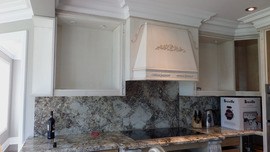 1 Backsplash: The upright surface, often made of tile, behind a kitchen counter, sink, or stove, that protects the wall from damage from splatter due to kitchen activities
1 Backsplash: The upright surface, often made of tile, behind a kitchen counter, sink, or stove, that protects the wall from damage from splatter due to kitchen activities
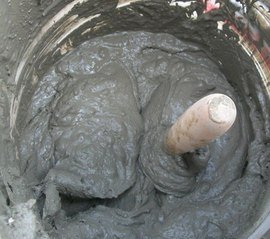 2 Mortar: A mixture of Portland cement or lime or a combination of both, sand, and water used to bind bricks, stones, and concrete masonry units together
2 Mortar: A mixture of Portland cement or lime or a combination of both, sand, and water used to bind bricks, stones, and concrete masonry units together
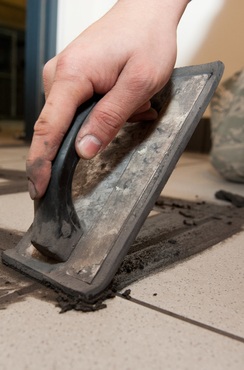 3 Grouted: A fluid form of cement used to seal the joints between tiles. It also makes the surface stronger because it bonds the tiles together
3 Grouted: A fluid form of cement used to seal the joints between tiles. It also makes the surface stronger because it bonds the tiles together
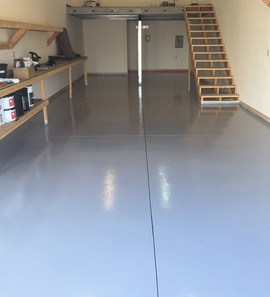 4 Epoxy: An adhesive, plastic, paint, or other material made from polymers containing epoxide groups. Epoxy is best used for bonding or for creating a protective coating
4 Epoxy: An adhesive, plastic, paint, or other material made from polymers containing epoxide groups. Epoxy is best used for bonding or for creating a protective coating
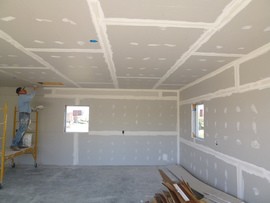 6 Drywall: Type of plasterboard, commonly used to build walls and ceilings, composed of gypsum that is layered between sheets of heavy paper
6 Drywall: Type of plasterboard, commonly used to build walls and ceilings, composed of gypsum that is layered between sheets of heavy paper
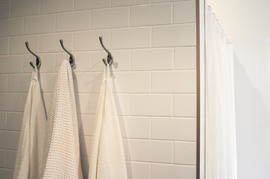 8 Subway tiles: A flat rectangular piece of glazed ceramic, traditionally 3-by-6 inches, used to decorate indoor walls and serve as a backsplash
8 Subway tiles: A flat rectangular piece of glazed ceramic, traditionally 3-by-6 inches, used to decorate indoor walls and serve as a backsplash
How much does it cost to install a backsplash in my city?
Cost to install a backsplash varies greatly by region (and even by zip code). To get free estimates from local contractors, please indicate yours.













